Promoting Effect of Microwave Field on Gas Phase Diffusion Limited Magnetite Reduction in Carbon Monoxide
Abstract
:1. Introduction
- Gas phase diffusion. This includes gas phase volume diffusion, pore diffusion, and gas-film diffusion of reducing and product gas.
- Solid phase diffusion. This includes the diffusion of the reduction process through the product layer and the internal diffusion of unreduced minerals.
- Interface reaction. This includes interface physics, chemical adsorption, and chemical reaction.
- Nucleation and growth. This includes the precipitation nucleation and growth of the new product phase.
2. Experiment
3. Results and Discussion
3.1. Reduction Indexes
3.2. Phases and Microscopic Morphology
3.3. Micro Kinetics
3.4. Microkinetics
3.5. Activation Energy
4. Conclusions
- Under the 60% CO-Ar atmosphere at 900–1100 °C, the metallization rate of the microwave field is 1.4 times that of the conventional field. The reduction degree of the microwave field is 1.2 times that of the conventional field. This shows that the microwave field can promote gas phase diffusion, but microwave irradiation does not significantly change the restrictive step. The promoting effect of the microwave field diminishes at higher temperature.
- Cross sections of magnetite particles were observed via SEM analysis. The morphologies of the reduced particles were similar for both microwave irradiation and conventional heating, with metallic iron forming a pointed-inward morphology causing the rupture of the particles. Under the condition of CO-limited reduction, the iron crystals produced by the reduction process under the microwave field and the conventional field are dense structures; porous components cannot be detected. The microwave field does not significantly change the morphology of the iron crystal. In addition to the influence of a reduction temperature and gas phase composition, the morphology of iron crystal can also be controlled by the reduction limiting step. This is a useful supplement to the conditions for the formation of iron crystal morphology. The morphology of iron crystals may be essentially controlled by the ratio of diffusion rate to reaction rate. When the diffusion rate is relatively low, it tends to produce dense structures.
- The microstructures of the reduction process under the microwave and conventional fields show that the reduction and crystallization of iron under the condition of CO reduction rate limiting is not like that of the H2 reduction, which will first produce a structure-coating layer around the exterior of the mineral. Instead, it is selectively crystallized from the microcracks generated by the stress in the early stage of the unreduced phase, and gradually expanded along the normal direction of the length of the ore powder. The in-depth growth results in the formation of strips of iron crystals that penetrate the ore powder and then expand outward width-ways, which is the result of CO adsorption orientation and mineral microdefects.
- Microwave irradiation can effectively improve the phenomenon of mineral sintering. The expansion of the material bed is obvious in the reduction process under the microwave field, whereas it is relatively small under the conventional field. The expansion phenomenon diminishes with the increase in temperature. The bed expansion provides a channel for gas diffusion and accelerates the reduction reaction.
- By contrast with the H2 reduction, the two reduction processes of CO reduction of Fe3O4 to FexO, and FexO to Fe, overlap. Due to the high potential for CO reduction in the near-surface region of the ore powder, iron is produced before reduction eliminates the Fe3O4. The reduction of Fe3O4 by H2 is divided into two independent cascade processes: Fe3O4 to FexO, and FexO to Fe.
- The JMA model was combined with the lnln method to determine the changes in the Avrami indexes m and k in the reduction process. It shows that the Avrami index m can be used to analyze the restrictive steps of the reduction process and its transformation. Under the condition of CO gas diffusion rate limiting, the reaction rate constant at 900 °C under the microwave field is 1.11–1.57 times higher than that under the conventional field at 900 °C. Microwave irradiation proves the most effective way to improve both the initial reduction rate and the reduction rate when the iron phase precipitates.
- Under the adopted experimental conditions, microwave irradiation reduced the activation energy of the reduction reaction. Microwave irradiation promoted the layer reduction phenomenon and directional reduction (the directional growth of the reduced iron phase) of the magnetite powder. Kinetic analysis of both the macroscopic linear model and the microscopic process shows that under the condition of gas diffusion as the limiting step, the activation energy of microwave irradiation reduction of magnetite concentrate powder is lower than that of conventional heating.
Author Contributions
Funding
Conflicts of Interest
References
- Raymond, L.; Leiv, K. Iron Ore Reduction with CO and H2 Gas Mixtures–Thermodynamic and Kinetic Modelling. In Proceedings of the 4th Ulcos Seminar, University of Wollongong. Available online: https://ro.uow.edu.au/engpapers/1260 (accessed on 1 October 2008).
- Hunt, J.; Ferrari, A.; Lita, A.; Crosswhite, M.; Ashley, B.; Stiegman, A.E. Microwave-specific Enhancement of the Carbon-carbon Dioxide (Boudouard) Reaction. J. Phys. Chem. C 2013, 117, 26871–26880. [Google Scholar] [CrossRef]
- Zhou, J.; Xu, W.; You, Z.; Wang, Z.; Luo, Y.; Gao, L.; Yin, C.; Peng, R.; Lan, L. A New Type of Power energy for Accelerating Chemical Reactions: The Nature of a Microwave-driving Force for Accelerating Chemical Reactions. Sci. Rep. 2016, 6, 25149. [Google Scholar] [CrossRef]
- Ayvaz, S.I.; Aydin, I. Effect of the Microwave Heating on Diffusion Kinetics and Mechanical Properties of Borides in AISI 316L. Indian Inst. Met. 2020, 73, 2635–2644. [Google Scholar] [CrossRef]
- Amini, A.; Ohno, K.; Maeda, T.; Kunitomo, K. Comparison between Microwave Heating and Conventional Heating of FeS-CaO Mixture during Hydrogen-Reduction. Chem. Eng. J. 2019, 374, 648–657. [Google Scholar] [CrossRef]
- Binner, J.G.P.; Al-Dawery, I.A.H. Microwave Melt Texturing of Bulk YBCO Superconductors. Supercond. Sci. Technol. 1998, 11, 1230–1236. [Google Scholar] [CrossRef]
- Chen, J.; Liu, L.; Zeng, J.Q. Experimental study on reduction of carbonaceous iron ore powder by microwave heating. Steel 2004, 39, 1–5. [Google Scholar] [CrossRef]
- Hayashi, M.; Takeda, K.; Kashimura, K.; Watanabe, T.; Nagata, K. Carbothermic Reduction of Hematite Powders by Microwave Heating. ISIJ Int. 2013, 53, 1125–1130. [Google Scholar] [CrossRef]
- Ishizaki, K.; Nagata, K.; Hayashi, T. Localized Heating and Reduction of Magnetite Ore with Coal in Composite Pellets Using Microwave Irradiation. ISIJ Int. 2007, 47, 817–822. [Google Scholar] [CrossRef]
- Hara, K.; Hayashi, M.; Sato, M.; Nagata, K. Pig Iron Making by Focused Microwave Beams with 20 kW at 2.45 GHz. Iron Steel Inst. Jpn. 2012, 52, 2149–2157. [Google Scholar] [CrossRef]
- Kashimura, K.; Sato, M.; Hotta, M.; Agrawal, D.K.; Nagata, K.; Hayashi, M.; Mitani, T.; Shinohara, N. Iron production from Fe3O4 and graphite by applying 915 MHz microwaves. Mater. Sci. Eng. A 2012, 556, 977–979. [Google Scholar] [CrossRef]
- Zhou, M.; Ai, L.; Hong, L.; Sun, C.; Yuan, Y.; Tong, S. Comparison of Microstructures of Magnetite Reduced by H2 and CO under Microwave Field. Metals 2023, 13, 1367. [Google Scholar] [CrossRef]
- Sun, C.; Ai, L.; Hong, L.; Li, Y. Study on solid state steelmaking from thin cast iron sheets through decarburization in H2O–H2. Ironmak. Steelmak. 2019, 47, 1015–1021. [Google Scholar] [CrossRef]
- Moujahid, S.E.; Rist, A. The Nucleation of Iron on Dense Wustite: A Morphological Study. Metall. Mater. Trans. B 1988, 19, 787–802. [Google Scholar] [CrossRef]
- Amini, A.; Ohno, K.I.; Maeda, T.; Kunitomo, K. Effect of the Ratio of Magnetite Particle Size to Microwave Penetration Depth on Reduction Reaction Behaviour by H2. Sci. Rep. UK 2018, 8, 15023. [Google Scholar] [CrossRef]
- Kim, S.H.; Zhang, X.; Ma, Y.; Filho, I.R.S.; Schweinar, K.; Angenendt, K.; Vogel, D.; Stephenson, L.T.; El-Zoka, A.A.; Mianroodi, J.R.; et al. Influence of microstructure and atomic-scale chemistry on the direct reduction of iron ore with hydrogen at 700 °C. Acta Mater. 2021, 212, 116933. [Google Scholar] [CrossRef]
- John, D.H.S.; Matthew, S.P.; Hayes, P.C. The breakdown of dense iron layers on wustite in CO/CO2 and H2/H2O systems. Metall. Mater. Trans. B 1984, 15, 701–708. [Google Scholar] [CrossRef]
- Matthew, S.P.; Cho, T.R.; Hayes, P.C. Mechanisms of porous iron growth on wustite and magnetite during gaseous reduction. Metall. Mater. Trans. B 1990, 21, 733–741. [Google Scholar] [CrossRef]
- Wei, J. Study on the Mechanism of the Difference in the Morphology of Iron Precipitated during the Reduction of FeO by CO and H2. Ph.D. Thesis, Chongqing University, Chongqing, China, 2018. [Google Scholar]
- Kuila, S.K.; Chatterjee, R.; Ghosh, D. Kinetics of Hydrogen Reduction of Magnetite Ore Fines. Int. J. Hydrogen Energy 2016, 41, 9256–9266. [Google Scholar] [CrossRef]
- Abolpoura, B.; Afsahia, M.; Azizkarimi, M. Reduction kinetics of magnetite concentrate particles by carbon monoxide. Miner. Process Extr. Metall. 2018, 127, 29–39. [Google Scholar] [CrossRef]
- Stir, M.; Ishizaki, K.; Vaucher, S.; Nicula, R. Mechanism and kinetics of the reduction of magnetite to iron during heating in a microwave E-field maximum. J. Appl. Phys. 2009, 105, 124901. [Google Scholar] [CrossRef]
- Janković, B. Kinetic analysis of the no isothermal decomposition of potassium metabisulfite using the model-fitting and is conversional (model-free) methods. Chem. Eng. J. 2008, 139, 128–135. [Google Scholar] [CrossRef]
- Hancock, J.D.; Sharp, J.H. Method of Comparing Solid-State Kinetic Data and Its Application to the Decomposition of Kaolinite, Brucite, and BaCO3. J. Am. Ceram. Soc. 2010, 55, 74–77. [Google Scholar] [CrossRef]
- Chen, J.; Zhang, R.; Simmonds, T.; Hayes, P.C. Microstructural Changes and Kinetics of Reduction of Hematite to Magnetite in CO/CO2 Gas Atmospheres. Metall. Trans. B 2019, 50, 2612–2622. [Google Scholar] [CrossRef]

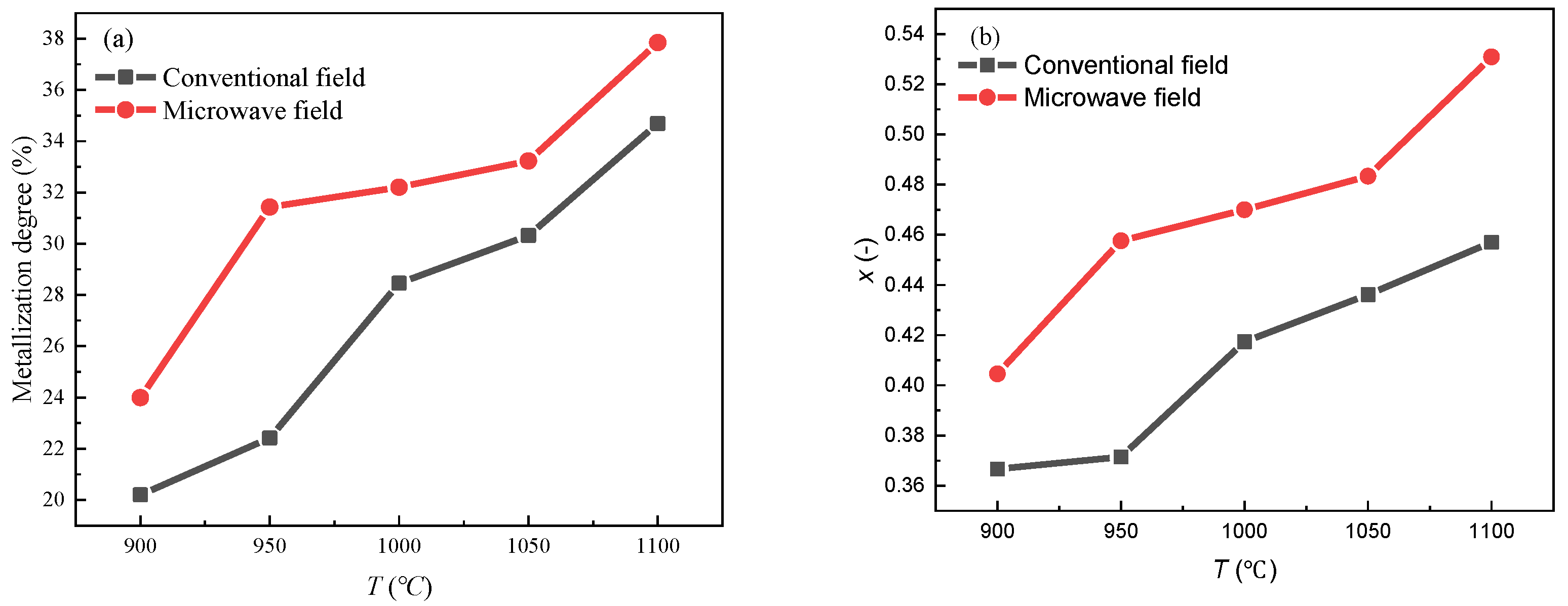


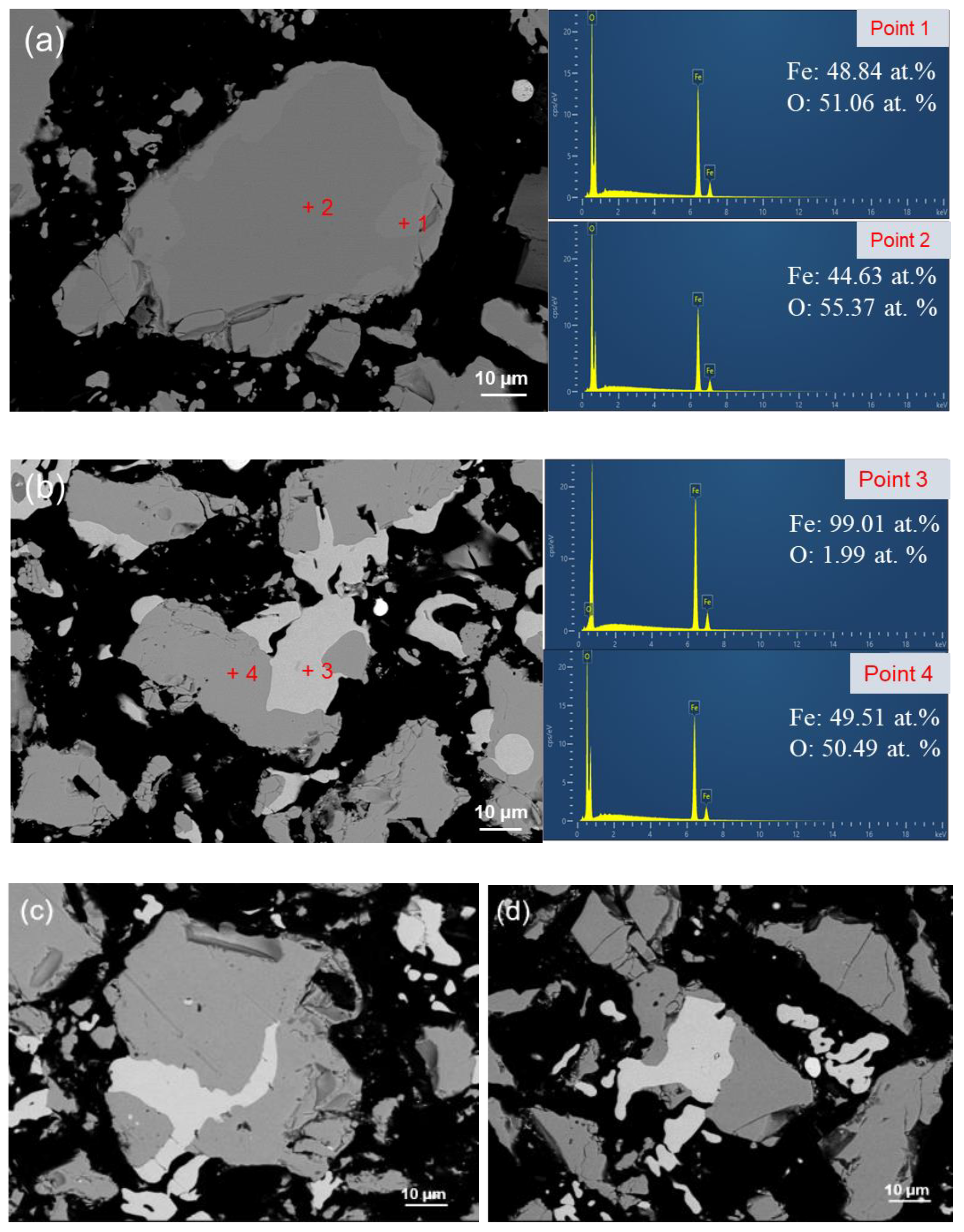


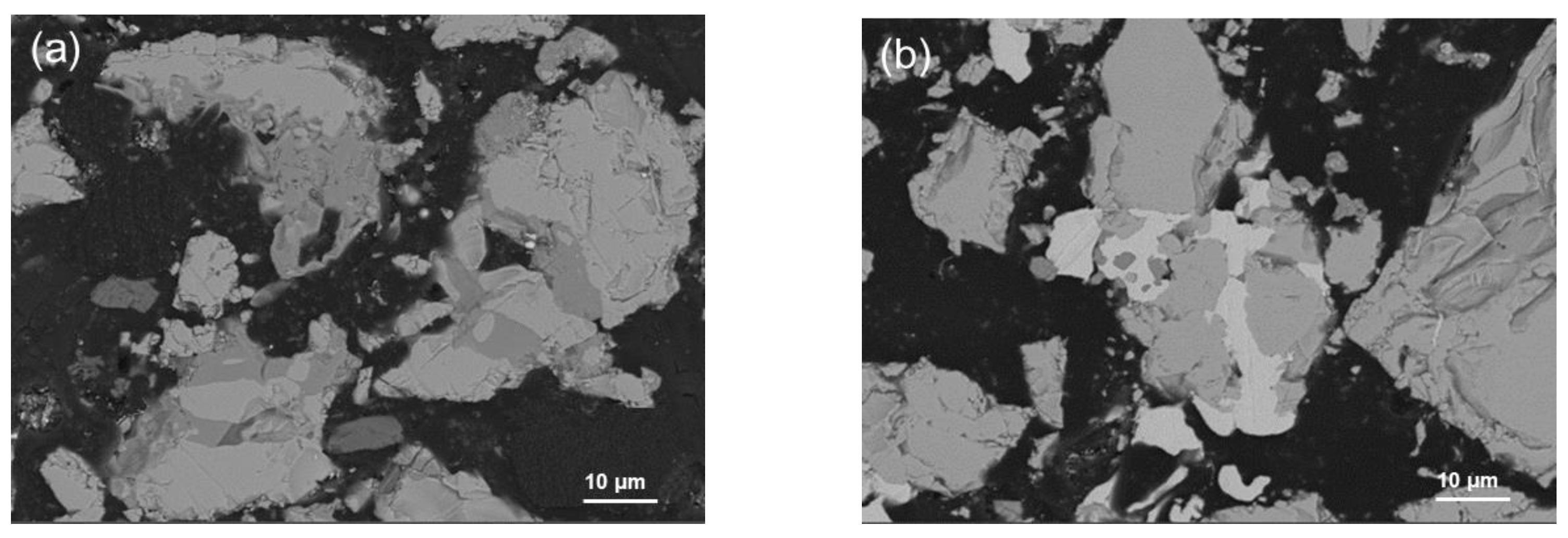


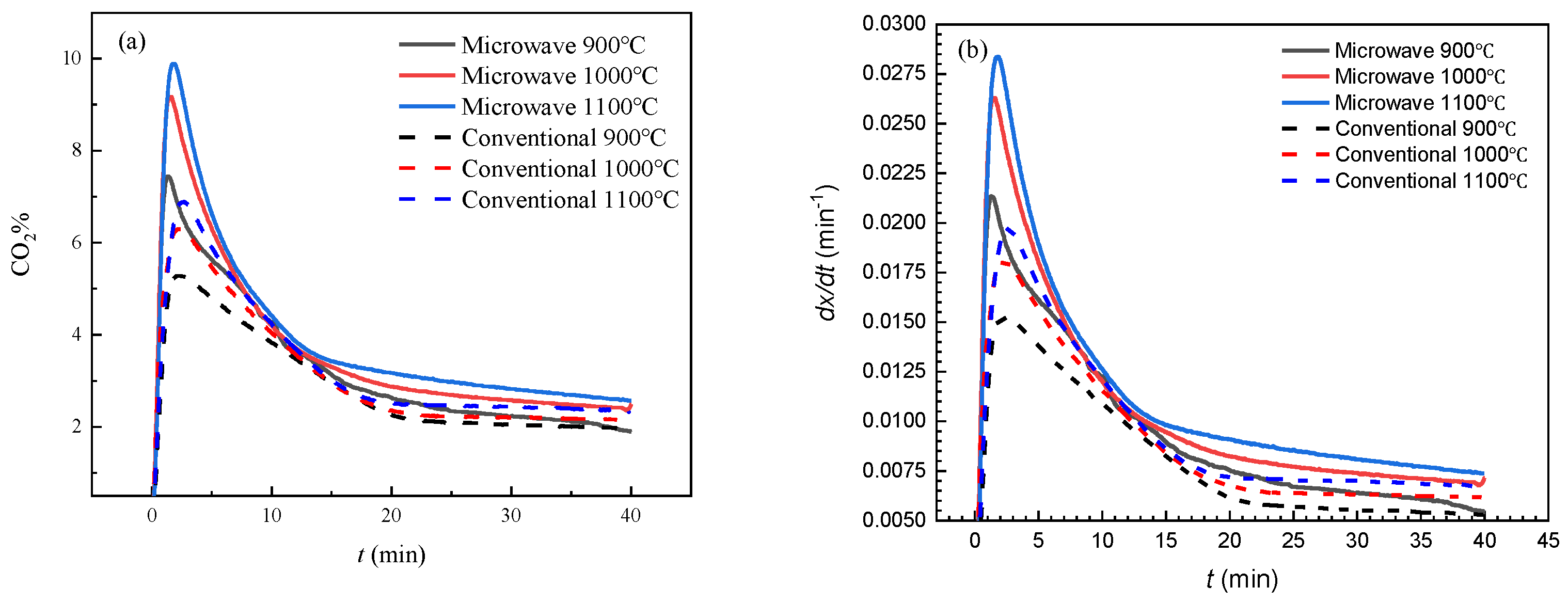
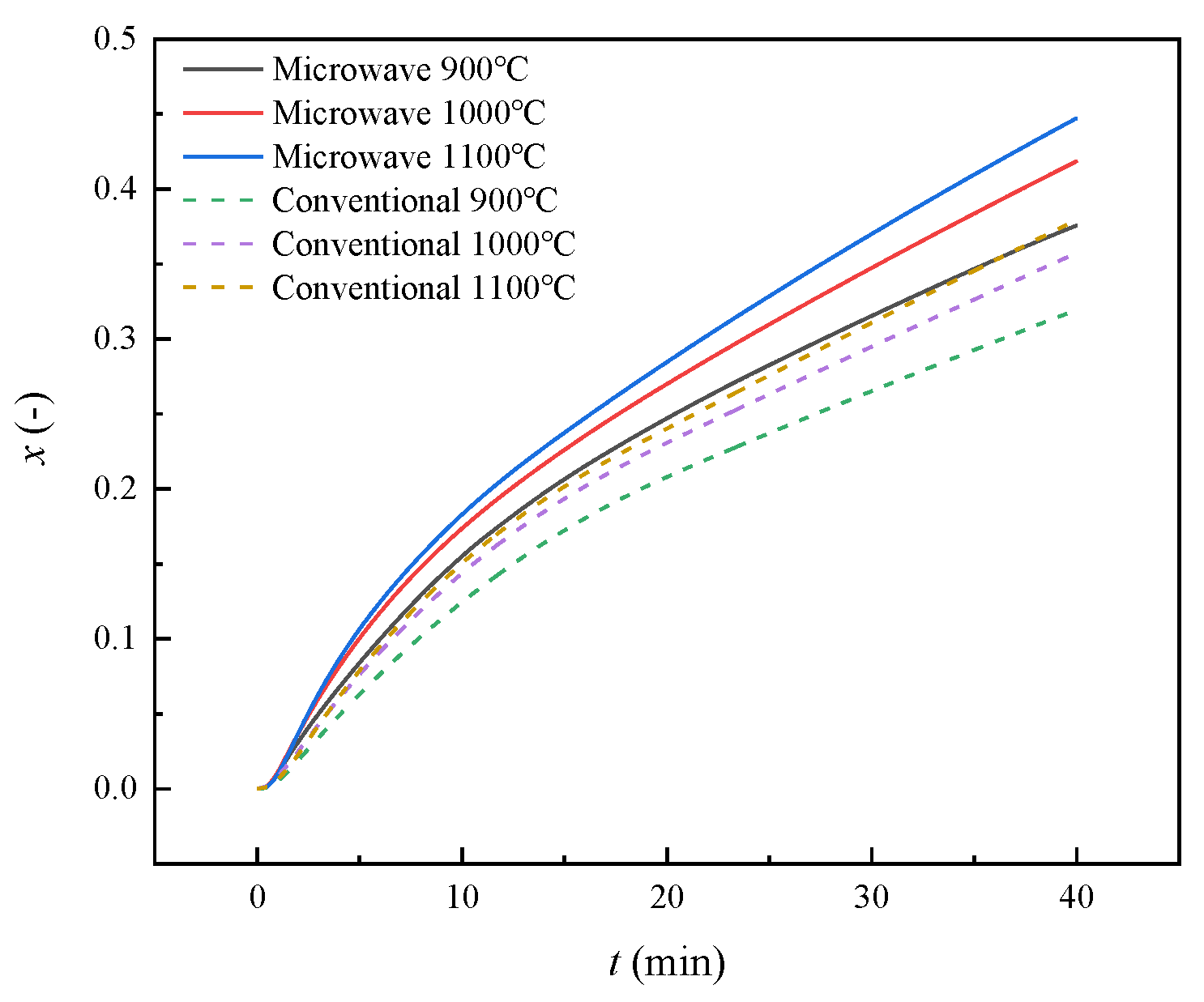


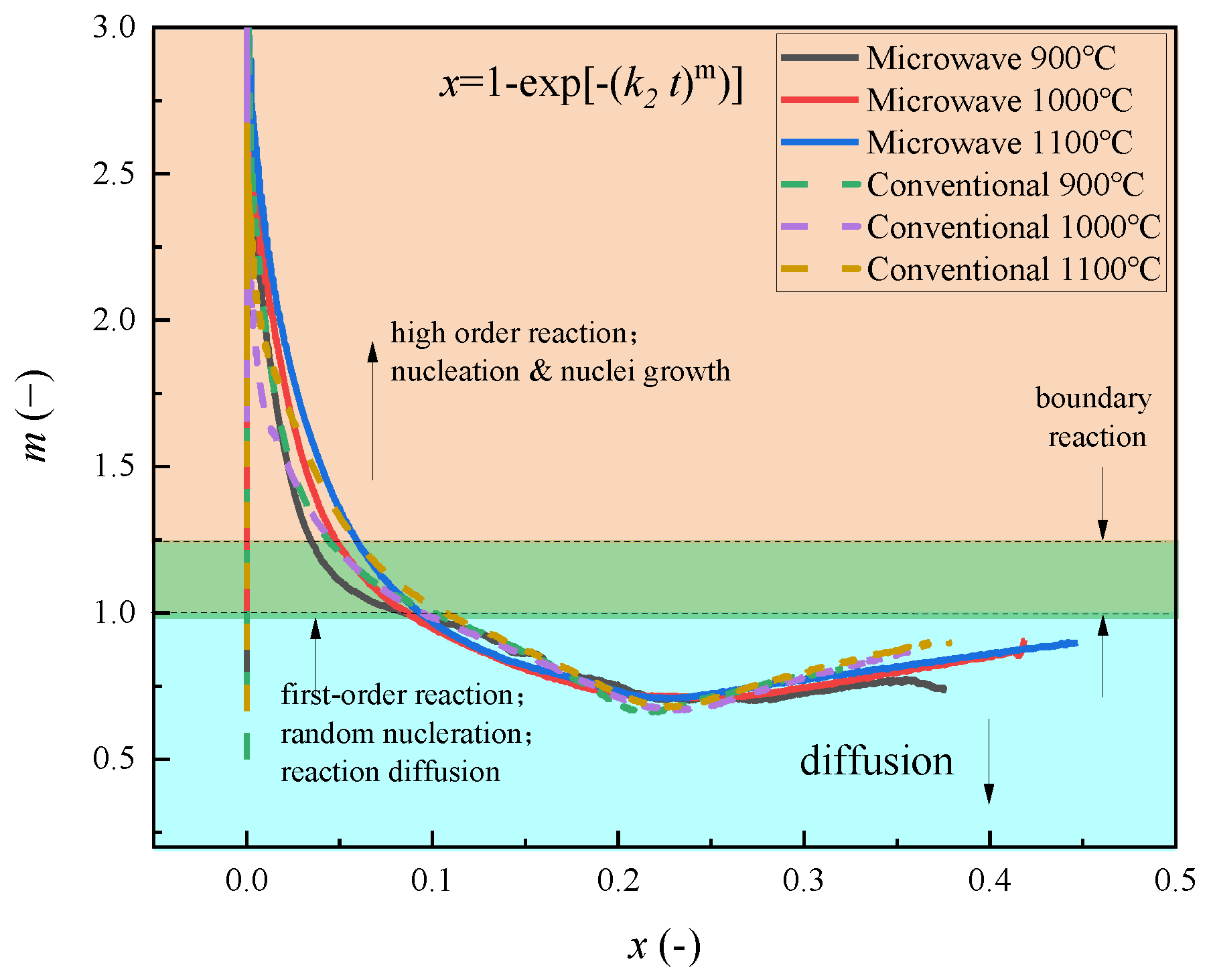
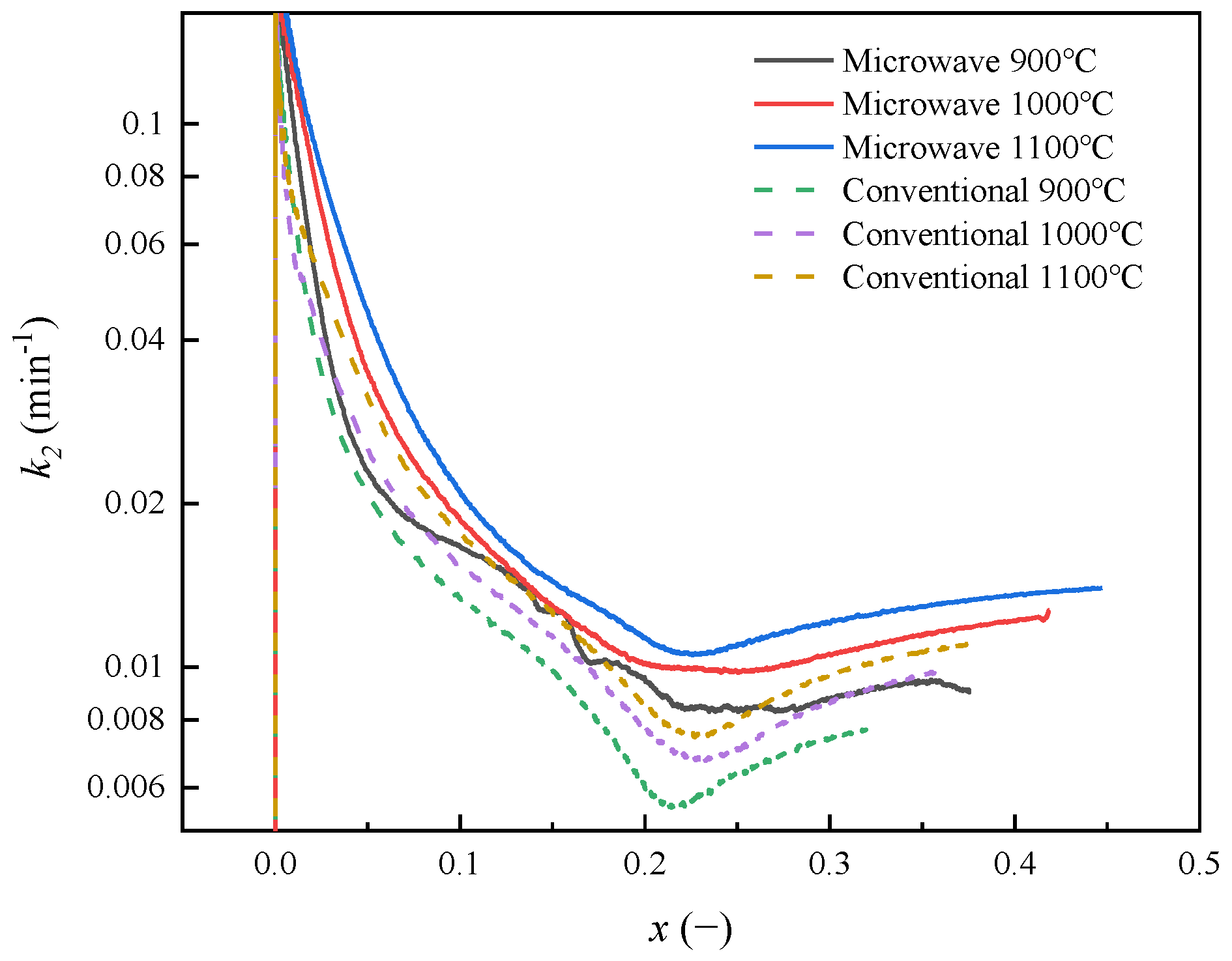
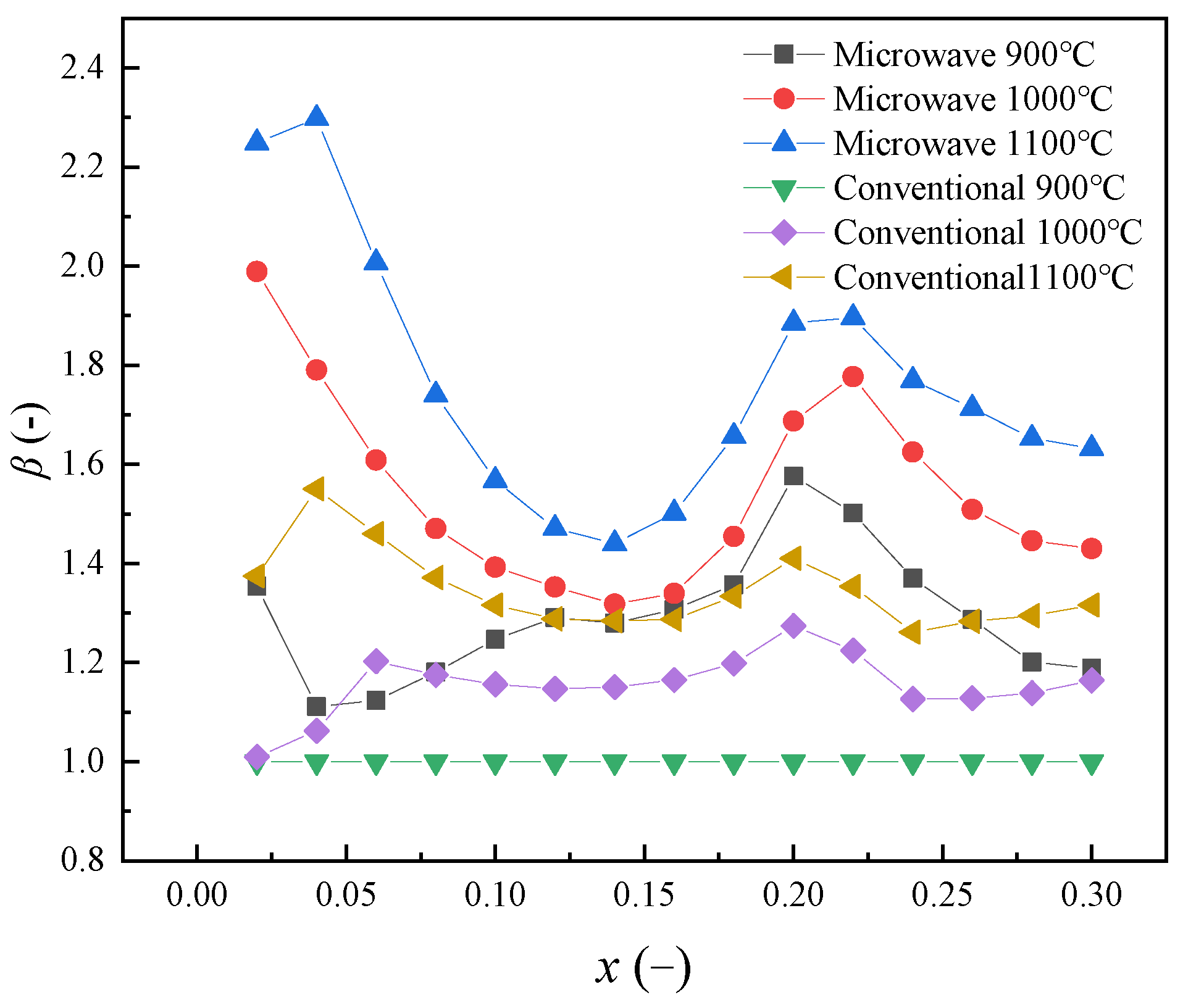
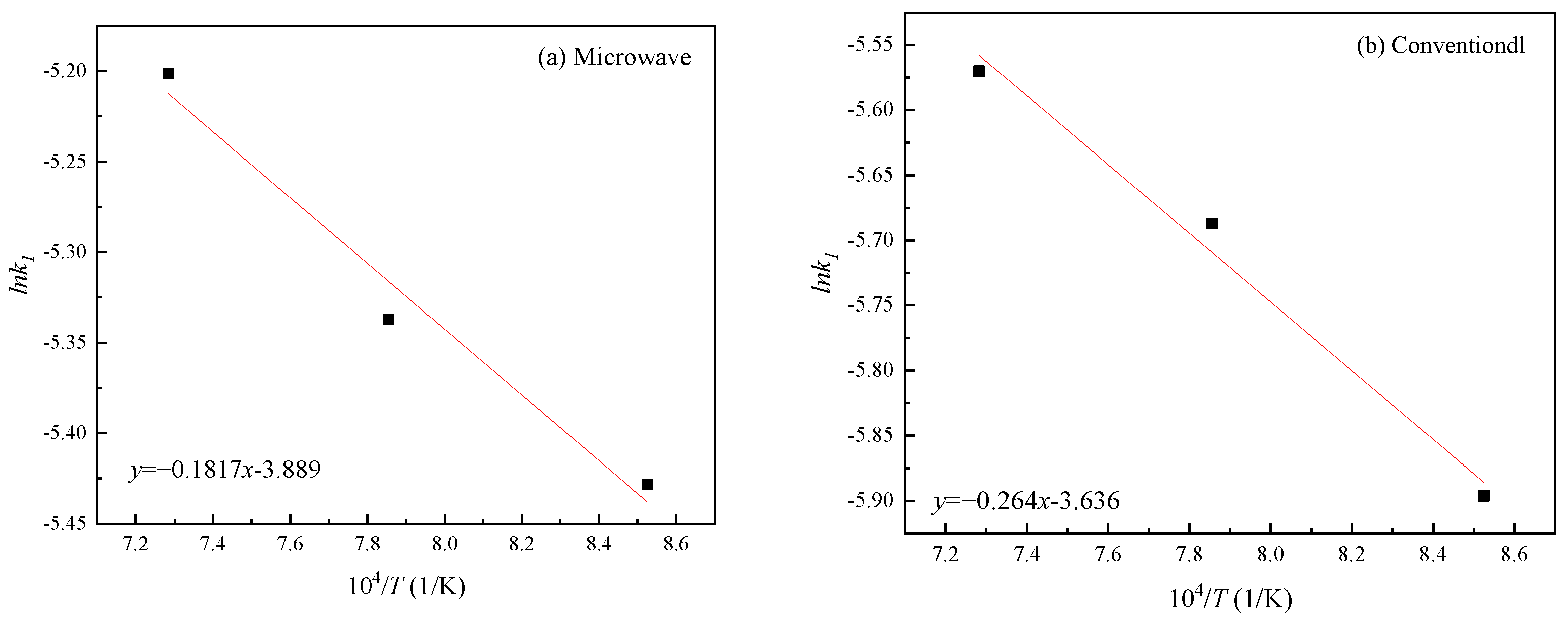

| No. | Reduction Mechanism | Equation y(x) = |
|---|---|---|
| 1 | phase-boundary-controlled reaction (infinite slabs) | |
| 2 | phase-boundary-controlled reaction (contracting cylinder) | |
| 3 | phase-boundary-controlled reaction (contracting sphere) | |
| 4 | one-dimensional diffusion | |
| 5 | two-dimensional diffusion | |
| 6 | three-dimensional diffusion | |
| 7 | first-order reaction (random nucleation) | |
| 8 | two-dimensional growth of nuclei (Avrami–Erofeyev equation) | |
| 9 | three-dimensional growth of nuclei (Avrami–Erofeyev equation) |
| R2 (900 °C) | R2 (1000 °C) | R2 (1100 °C) | |
|---|---|---|---|
| 1 | 0.9653 | 0.9677 | 0.9809 |
| 2 | 0.9771 | 0.9796 | 0.9896 |
| 3 | 0.9804 | 0.9829 | 0.9919 |
| 4 | 0.9956 | 0.9947 | 0.9950 |
| 5 | 0.9915 | 0.9898 | 0.9897 |
| 6 | 0.9896 | 0.9876 | 0.9873 |
| 7 | 0.9863 | 0.9886 | 0.9953 |
| 8 | 0.8923 | 0.8959 | 0.9563 |
| 9 | 0.8195 | 0.8197 | 0.9314 |
| R2 (900 °C) | R2 (1000 °C) | R2 (1100 °C) | |
|---|---|---|---|
| 1 | 0.9719 | 0.9755 | 0.9784 |
| 2 | 0.9791 | 0.9829 | 0.9858 |
| 3 | 0.9812 | 0.9851 | 0.9879 |
| 4 | 0.9981 | 0.9973 | 0.9954 |
| 5 | 0.9963 | 0.9945 | 0.9916 |
| 6 | 0.9955 | 0.9933 | 0.9900 |
| 7 | 0.9852 | 0.9889 | 0.9915 |
| 8 | 0.9352 | 0.9442 | 0.9485 |
| 9 | 0.9087 | 0.9197 | 0.9236 |
Disclaimer/Publisher’s Note: The statements, opinions and data contained in all publications are solely those of the individual author(s) and contributor(s) and not of MDPI and/or the editor(s). MDPI and/or the editor(s) disclaim responsibility for any injury to people or property resulting from any ideas, methods, instructions or products referred to in the content. |
© 2023 by the authors. Licensee MDPI, Basel, Switzerland. This article is an open access article distributed under the terms and conditions of the Creative Commons Attribution (CC BY) license (https://creativecommons.org/licenses/by/4.0/).
Share and Cite
Zhou, M.; Ai, L.; Hong, L.; Sun, C.; Tong, S. Promoting Effect of Microwave Field on Gas Phase Diffusion Limited Magnetite Reduction in Carbon Monoxide. Processes 2023, 11, 2709. https://doi.org/10.3390/pr11092709
Zhou M, Ai L, Hong L, Sun C, Tong S. Promoting Effect of Microwave Field on Gas Phase Diffusion Limited Magnetite Reduction in Carbon Monoxide. Processes. 2023; 11(9):2709. https://doi.org/10.3390/pr11092709
Chicago/Turabian StyleZhou, Meijie, Liqun Ai, Lukuo Hong, Caijiao Sun, and Shuai Tong. 2023. "Promoting Effect of Microwave Field on Gas Phase Diffusion Limited Magnetite Reduction in Carbon Monoxide" Processes 11, no. 9: 2709. https://doi.org/10.3390/pr11092709





